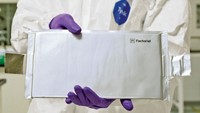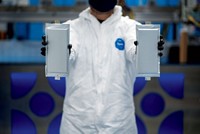Advertisement
Grab your lab coat. Let's get started
Welcome!
Welcome!
Create an account below to get 6 C&EN articles per month, receive newsletters and more - all free.
It seems this is your first time logging in online. Please enter the following information to continue.
As an ACS member you automatically get access to this site. All we need is few more details to create your reading experience.
Not you? Sign in with a different account.
Not you? Sign in with a different account.
ERROR 1
ERROR 1
ERROR 2
ERROR 2
ERROR 2
ERROR 2
ERROR 2
Password and Confirm password must match.
If you have an ACS member number, please enter it here so we can link this account to your membership. (optional)
ERROR 2
ACS values your privacy. By submitting your information, you are gaining access to C&EN and subscribing to our weekly newsletter. We use the information you provide to make your reading experience better, and we will never sell your data to third party members.
Energy Storage
Sila Nanotechnologies raises $170 million for silicon anodes
California start-up is working with Daimler and BMW to boost electric-vehicle battery power
by Melody M. Bomgardner
April 16, 2019
| A version of this story appeared in
Volume 97, Issue 16

Sila Nanotechnologies, a California-based battery materials start-up, has raised $170 million in a fourth round of funding, led by the automaker Daimler, to advance its technology for battery anodes made with silicon. Sila launched in 2011 and has now brought in $295 million from investors.
Efforts to increase the energy density of lithium-ion batteries have focused mainly on new recipes for the cathode. But performance gains have slowed, prodding materials scientists to turn to the anode.
Lithium-ion battery anodes are typically made of graphite. Incorporating silicon has the potential to improve energy density by 20–40%, experts say. Indeed, Sila says it has already demonstrated that its porous anode composite boosts battery energy density by 20%.
“We’ve cracked the code on silicon thanks to eight years and 35,000 iterations developing our materials to improve battery storage capacity,” Sila CEO Gene Berdichevsky says.
It’s not easy to make an anode from silicon that will last over hundreds or thousands of charge and discharge cycles. Silicon anodes can swell to more than three times their size during charging due to absorption of lithium ions.
Other companies that are also working to solve this problem include the silicon maker Wacker Chemie, the UK start-up Nexeon, and US battery firm Amprius.
Sila says the new funds will help it scale up production. It plans to supply customers in consumer electronics within the next year. In the longer term, it is working with Daimler and BMW to enter the electric vehicle battery market. Daimler will get a seat on Sila’s board, as will former General Electric CEO Jeff Immelt. Daimler’s Mercedes-Benz unit has vowed to electrify its full range of cars by 2022.




Join the conversation
Contact the reporter
Submit a Letter to the Editor for publication
Engage with us on Twitter